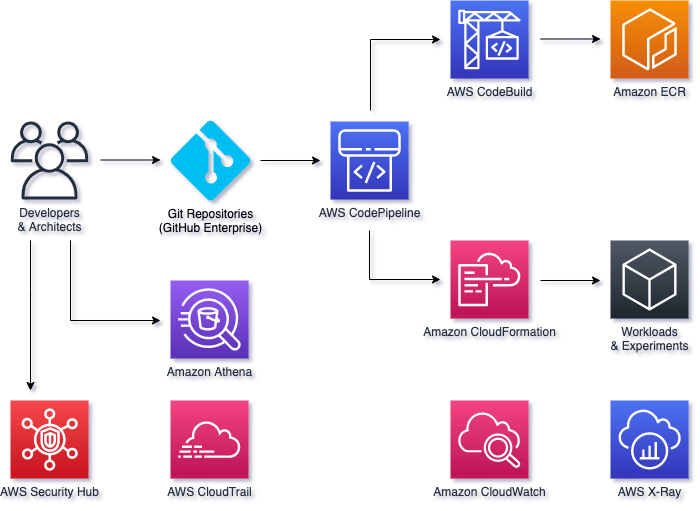AWS DevOps Blog
Choosing a CI/CD approach: AWS Services with BigHat Biosciences
Founded in 2019, BigHat Biosciences’ mission is to improve human health by reimagining antibody discovery and engineering to create better antibodies faster. Their integrated computational + experimental approach speeds up antibody design and discovery by combining high-speed molecular characterization with machine learning technologies to guide the search for better antibodies. They apply these design capabilities to develop new generations of safer and more effective treatments for patients suffering from today’s most challenging diseases. Their platform, from wet lab robots to cloud-based data and logistics plane, is woven together with rapidly changing BigHat-proprietary software. BigHat uses continuous integration and continuous deployment (CI/CD) throughout their data engineering workflows and when training and evaluating their machine learning (ML) models.

In a previous post, we discussed the key considerations when choosing a CI/CD approach. In this post, we explore BigHat’s decisions and motivations in adopting managed AWS CI/CD services. You may find that your organization has commonalities with BigHat and some of their insights may apply to you. Throughout the post, considerations are informed and choices are guided by the best practices in the AWS Well-Architected Framework.
How did BigHat decide what they needed?
Making decisions on appropriate (CI/CD) solutions requires understanding the characteristics of your organization, the environment you operate in, and your current priorities and goals.
“As a company designing therapeutics for patients rather than software, the role of technology at BigHat is to enable a radically better approach to develop therapeutic molecules,” says Eddie Abrams, VP of Engineering at BigHat. “We need to automate as much as possible. We need the speed, agility, reliability and reproducibility of fully automated infrastructure to enable our company to solve complex problems with maximum scientific rigor while integrating best in class data analysis. Our engineering-first approach supports that.”
BigHat possesses a unique insight to an unsolved problem. As an early stage startup, their core focus is optimizing the fully integrated platform that they built from the ground-up to guide the design for better molecules. They respond to feedback from partners and learn from their own internal experimentation. With each iteration, the quality of what they’re creating improves, and they gain greater insight and improved models to support the next iteration. More than anything, they need to be able to iterate rapidly. They don’t need any additional complexity that would distract from their mission. They need uncomplicated and enabling solutions.
They also have to take into consideration the regulatory requirements that apply to them as a company, the data they work with and its security requirements; and the market segment they compete in. Although they don’t control these factors, they can control how they respond to them, and they want to be able to respond quickly. It’s not only speed that matters in designing for security and compliance, but also visibility and track-ability. These often overlooked and critical considerations are instrumental in choosing a CI/CD strategy and platform.
“The ability to learn faster than your competitors may be the only sustainable competitive advantage,” says Cindy Alvarez in her book Lean Customer Development.
The tighter the feedback loop, the easier it is to make a change. Rapid iteration allows BigHat to easily build upon what works, and make adjustments as they identify avenues that won’t lead to success.
Feature set
CI/CD is applicable to more than just the traditional use case. It doesn’t have to be software delivered in a classic fashion. In the case of BigHat, they apply CI/CD in their data engineering workflows and in training their ML models. BigHat uses automated solutions in all aspects of their workflow. Automation further supports taking what they have created internally and enabling advances in antibody design and development for safer, more effective treatments of conditions.
“We see a broadening of the notion of what can come under CI/CD,” says Abrams. “We use automated solutions wherever possible including robotics to perform scaled assays. The goal in tightening the loop is to improve precision and speed, and reduce latency and lag time.”
BigHat reached the conclusion that they would adopt managed service offerings wherever possible, including in their CI/CD tooling and other automation initiatives.
“The phrase ‘undifferentiated heavy lifting’ has always resonated,” says Abrams. “Building, scaling, and operating core software and infrastructure are hard problems, but solving them isn’t itself a differentiating advantage for a therapeutics company. But whether we can automate that infrastructure, and how we can use that infrastructure at scale on a rock solid control plane to provide our custom solutions iteratively, reliably and efficiently absolutely does give us an edge. We need an end-to-end, complete infrastructure solution that doesn’t force us to integrate a patchwork of solutions ourselves. AWS provides exactly what we need in this regard.”
Reducing risk
Startups can be full of risk, with the upside being potential future reward. They face risk in finding the right problem, in finding a solution to that problem, and in finding a viable customer base to buy that solution.
A key priority for early stage startups is removing risk from as many areas of the business as possible. Any steps an early stage startup can take to remove risk without commensurately limiting reward makes them more viable. The more risk a startup can drive out of their hypothesis the more likely their success, in part because they’re more attractive to customers, employees, and investors alike. The more likely their product solves their problem, the more willing a customer is to give it a chance. Likewise, the more attractive they are to investors when compared to alternative startups with greater risk in reaching their next major milestone.
Adoption of managed services for CI/CD accomplishes this goal in several ways. The most important advantage remains speed. The core functionality required can be stood up very quickly, as it’s an existing service. Customers have a large body of reference examples and documentation available to demonstrate how to use that service. They also insulate teams from the need to configure and then operate the underlying infrastructure. The team remains focused on their differentiation and their core value proposition.
“We are automated right up to the organizational level and because of this, running those services ourselves represents operational risk,” says Abrams. “The largest day-to-day infrastructure risk to us is having the business stalled while something is not working. Do I want to operate these services, and focus my staff on that? There is no guarantee I can just throw more compute at a self-managed software service I’m running and make it scale effectively. There is no guarantee that if one datacenter is having a network or electrical problem that I can simply switch to another datacenter. I prefer AWS manages those scale and uptime problems.”
Embracing an opinionated model
BigHat is a startup with a singular focus on using ML to reduce the time and difficulty of designing antibodies and other therapeutic proteins. By adopting managed services, they have removed the burden of implementing and maintaining CI/CD systems.
Accepting the opinionated guardrails of the managed service approach allows, and to a degree reinforces, the focus on what makes a startup unique. Rather than being focused on performance tuning, making decisions on what OS version to use, or which of the myriad optional puzzle pieces to put together, they can use a well-integrated set of tools built to work with each other in a defined fashion.
The opinionated model means best practices are baked into the toolchain. Instead of hiring for specialized administration skills they’re hiring for specialized biotech skills.
“The only degrees of freedom I care about are the ones that improve our technologies and reduce the time, cost, and risk of bringing a therapeutic to market,” says Abrams. “We focus on exactly where we can gain operational advantages by simply adopting managed services that already embrace the Well-Architected Framework. If we had to tackle all of these engineering needs with limited resources, we would be spending into a solved problem. Before AWS, startups just didn’t do these sorts of things very well. Offloading this effort to a trusted partner is pretty liberating.”
Beyond the reduction in operational concerns, BigHat can also expect continuous improvement of that service over time to be delivered automatically by the provider. For their use case they will likely derive more benefit for less cost over time without any investment required.
Overview of solution
BigHat uses the following key services:
- Code – GitHub for source code management.
- Test and build – AWS CodePipeline as the orchestration layer to manage build and test flows through AWS CodeBuild (compute workers for CI jobs).
- Publish stage – Amazon Elastic Container Registry (Amazon ECR) stores the infrastructure containers for the runners and product containers. AWS Code Artifact stores and serves our development and production distributables.
- Observability – Amazon CloudWatch Logs, Insights, Dashboards, and AWS X-Ray provide logging, metrics, and tracing. AWS CloudTrail and Amazon Athena provide deep insight into our API and object level security. AWS Security Hub is our window into our security posture.
- Infrastructure As Code – AWS CloudFormation is used to define and deploy all resources.

Security
Managed services are supported, owned and operated by the provider . This allows BigHat to leave concerns like patching and security of the underlying infrastructure and services to the provider. BigHat continues to maintain ownership in the shared responsibility model, but their scope of concern is significantly narrowed. The surface area the’re responsible for is reduced, helping to minimize risk. Choosing a partner with best in class observability, tracking, compliance and auditing tools is critical to any company that manages sensitive data.
Cost advantages
A startup must also make strategic decisions about where to deploy the capital they have raised from their investors. The vendor managed services bring a model focused on consumption, and allow the startup to make decisions about where they want to spend. This is often referred to as an operational expense (OpEx) model, in other words “pay as you go”, like a utility. This is in contrast to a large upfront investment in both time and capital to build these tools. The lack of need for extensive engineering efforts to stand up these tools, and continued investment to evolve them, acts as a form of capital expenditure (CapEx) avoidance. Startups can allocate their capital where it matters most for them.
“This is corporate-level changing stuff,” says Abrams. “We engage in a weekly leadership review of cost budgets. Operationally I can set the spending knob where I want it monthly, weekly or even daily, and avoid the risks involved in traditional capacity provisioning.”
The right tool for the right time
A key consideration for BigHat was the ability to extend the provider managed tools, where needed, to incorporate extended functionality from the ecosystem. This allows for additional functionality that isn’t covered by the core managed services, while maintaining a focus on their product development versus operating these tools.
Startups must also ask themselves what they need now, versus what they need in the future. As their needs change and grow, they can augment, extend, and replace the tools they have chosen to meet the new requirements. Starting with a vendor-managed service is not a one-way door; it’s an opportunity to defer investment in building and operating these capabilities yourself until that investment is justified. The time to value in using managed services initially doesn’t leave a startup with a sunk cost that limits future options.
“You have to think about the degree you want to adopt a hybrid model for the services you run. Today we aren’t running any software or services that require us to run our own compute instances. It’s very rare we run into something that is hard to do using just the services AWS already provides. Where our needs are not met, we can communicate them to AWS and we can choose to wait for them on their roadmap, which we have done in several cases, or we can elect to do it ourselves,” says Abrams. “This freedom to tweak and expand our service model at will is incomparably liberating.”
Conclusion
BigHat Biosciences was able to make an informed decision by considering the priorities of the business at this stage of its lifecycle. They adopted and embraced opinionated and service provider-managed tooling, which allowed them to inherit a largely best practice set of technology and practices, de-risk their operations, and focus on product velocity and customer feedback. This maintains future flexibility, which delivers significantly more value to the business in its current stage.
“We believe that the underlying engineering, the underlying automation story, is an advantage that applies to every aspect of what we do for our customers,” says Abrams. “By taking those advantages into every aspect of the business, we deliver on operations in a way that provides a competitive advantage a lot of other companies miss by not thinking about it this way.”
About the authors
 Mike is a Principal Solutions Architect with the Startup Team at Amazon Web Services. He is a former founder, current mentor, and enjoys helping startups live their best cloud life.
Mike is a Principal Solutions Architect with the Startup Team at Amazon Web Services. He is a former founder, current mentor, and enjoys helping startups live their best cloud life.
 Sean is a Senior Startup Solutions Architect at AWS. Before AWS, he was Director of Scientific Computing at the Howard Hughes Medical Institute.
Sean is a Senior Startup Solutions Architect at AWS. Before AWS, he was Director of Scientific Computing at the Howard Hughes Medical Institute.